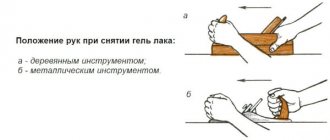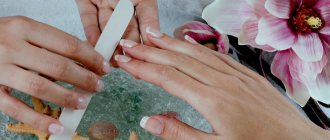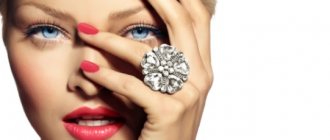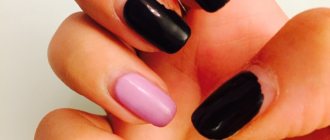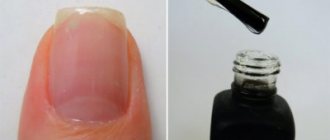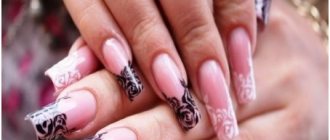- 1 Shellac: harmful or beneficial for nails
- 2 How to reduce harm from gel polishes?
- 3 How to quickly restore nails after shellac
- 4 Some tips for craftsmen
- 5 How to reduce the harm of gel nail polish on healthy hands
- 6 Nails after shellac
- 7 Does gel coating harm pregnant women and nursing mothers?
- 8 Gel polish – benefit or harm?
- 9 Myth 2: nails turn yellow.
- 10 Is gel polish harmful to health?
- 11 Manufacturers of harmless coatings
- 12 Scientists: shellac is dangerous to health 12.1 What is shellac
- 12.2 Why shellac is dangerous
- 12.3 How to protect yourself
Shellac: harmful or beneficial for nails
Of course, if you compare regular varnish, shellac, gel or acrylic for extensions, then the influence of the last two is most harmful to the nail plate. This is mainly explained by the gross trauma to the nail that it is subjected to during application and correction, as well as the unsafe chemical composition of the modeling material (especially the inclusion of formaldehyde). But shellac, in this case, also harms the plate, making it thinner, and this is due to the same grinding, which requires removing the top smooth layer to obtain a rough structure, which ensures good adhesion to the coating.
The next point in the question: why shellac is harmful for nails is damage to the nail plate when removed. Your nails will be beautiful for only 2-3 weeks, and then you will need to renew the coating. To perform a new manicure, the used gel polish is removed using a remover or a special composition made on the basis of acetone. When choosing the latter, the nails are treated with a solution, after which, after wrapping each finger with foil, you must wait for the chemical reaction to complete for 10-20 minutes (the duration depends on the manufacturer) and remove the softened substance with a stick.
As for whether gel nail polish is harmful in composition, scientists have made an unambiguous conclusion: if it does not contain formaldehydes, then the solution itself does not pose a danger to nails. The only exception is the products of some manufacturers, who, in order to reduce the cost, add harmful solvents, plasticizers, resins and low-quality preservatives to it.
One cannot help but compare shellac with regular varnishes and false nails, which many consider the safest solution. If you look at it, gel polish has its advantages and is less harmful:
- • firstly, it lasts for 3 weeks, and only then will you need to remove the coating and expose your nails to an acetone composition, whereas regular polish will last for a maximum of two days;
- • secondly, conventional varnishes contain formaldehyde, toluene, dibutyl phthalate (a dangerous flavoring agent that negatively affects the respiratory system and the thyroid gland), while shellac is a modern development that excludes the presence of these components;
- • thirdly, do not forget that glue for false nails also has a rather harmful composition, including formaldehyde.
Now, for the sake of objectivity, it is necessary to clarify what is the benefit of this coating
It also exists, and it lies in the fact that you will always look “at your best,” because hands are the second face of a woman, they always attract the attention of men. Shellac eliminates unpleasant situations when, after a completely fresh manicure, the varnish cracks, breaks, or peels off.
The innovative solution is stronger and more reliable, in addition, it saves time and nerves.
Consequences of the procedure
Girls who have bad memories of this procedure share stories of the consequences of shellac, photos taken from the comments they attached. TO
Salon clients share horror stories about how difficult it is to remove this product after two weeks. Many people renounce such a procedure forever.
Nail salon workers agree that sad stories arise from the use of low-quality materials. If good Shellac is used in your salon, the process of removing it from the plate will take no more than 5 minutes without any consequences. Find out more about whether shellac can be done while pregnant.
How to reduce harm from gel polishes?
If the nail materials are of high quality, then we can assume that the harm from their application will be the lowest. And yet, there are tips that will protect your nails from tarnishing and brittleness that appears from any gel polish if abused. So, the main recommendations for lovers of attractive hands:
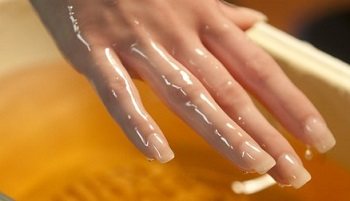
- The nail coating technology must be strictly observed; no deviations from the rules are allowed.
- After 2-4 sessions of using gel polish, take a break for a month (at least 2 weeks), undergoing a course of therapeutic coatings, paraffin therapy and other procedures (for severe lamination, fruit acids and wax sealing are used). It is advisable to supplement salon nail restoration procedures with homemade ones (masks, baths).
- Never apply gel polish to sick, peeling nails, or nail plates with fungus: first they need to be nourished, treated, and then made beautiful with the help of artificial materials.
- Before applying gel polish, it is good to saturate your nails with calcium using medicinal varnishes, which are available in any pharmacy.
- If your nails have taken on an unhealthy appearance, then you need to undergo a course of vitamin therapy.
When the skin around the nails is cracked and too sensitive, decorative coatings cannot be applied until it is restored. A manicure should always be done before applying gel polish, and not after. It is necessary to regularly rub special oils into the cuticle area.
You will find the nail technician's answers to the question about the dangers of gel nail polish and tips on minimizing the harm in the video.
Gel polish has many advantages (convenience, beauty, no damage even when doing homework), and they should definitely be taken into account. In order for a manicure to bring aesthetic pleasure and not cause harm, you need to choose a highly qualified master and not skimp on materials. Then you won't have to worry about your nails!
Strip under the nail
Subungual melanoma is a form of acral lentiginous melanoma, which in turn is a type of cutaneous melanoma, an aggressive cancer with a high mortality rate.
“The proportion of acral lentiginous melanoma varies in different regions of the world and averages 5% of all types of melanoma. Tumors are more often localized in the area of the feet, of which a quarter are subungual melanomas,” notes Grigory Zinoviev, Candidate of Medical Sciences, oncologist, surgeon, head of the surgical department of tumors of bones, soft tissues and skin, National Medical Research Center of Oncology. N. N. Petrova.
6963 Evil under the sun: how to save yourself from the most common type of cancer
Subungual melanoma has two stages of development: horizontal and vertical. At first, the tumor looks like a brown or black stripe under the nail. Then the free edge of the nail, the nail fold and the skin are gradually pigmented. In a third of cases, amelanotic melanoma occurs, which is difficult to notice.
The first symptoms develop at the vertical stage, when the tumor grows into neighboring tissues: the nail becomes deformed, the nail plate becomes dull, becomes thinner and breaks. When the nail cracks, you can see a lumpy, bleeding surface that is brown or black underneath.
As the tumor progresses, it can spread to the fingers, feet, or hands. The patient experiences weakness, loses weight, and develops a fever. The rate at which the disease develops varies—metastases may appear within a year or several years.
How to quickly restore nails after shellac
If after such a manicure your nails are damaged and weakened, then they will need special care. The following recommendations will help you quickly restore your nail plates:
- To moisturize, you need to take baths regularly. A mixture of medicinal herbs is perfect for these purposes. In a small container, move mint, thyme and sage. Pour in boiling water and let the product brew. After this, add a little olive oil into it. You need to keep your hands in the warm broth for 10 minutes. At the end of the procedure, blot the remaining product with a napkin.
- Nourish your nails and the skin around them with special creams. They must be applied regularly at any time of the year.
- Procedures using lemon will help saturate your nail plates with vitamins. To do this, cut the lemon into two halves. Dip your nails directly into the citrus pulp. Hold for about five minutes. Such sessions should be carried out once a week.
- Baths with sea salt will help strengthen your nails. You can add various essential oils to them. The duration of one session is about 10 minutes. Such procedures are carried out once a week.
- Today, pharmacies offer a wide range of different medicinal nail coatings. They are enriched with vitamins and minerals. Apply like regular nail polish. Most often they are colorless and add only a slight shine to the nails.
- The beauty salon can offer you a Japanese manicure. This procedure has a beneficial effect on the condition of the nails. A special paste is applied to the hands, which fills the nail with nutrients. As a result, you will get a neat, shiny manicure.
- Perform paraffin therapy periodically. To do this, purchase paraffin enriched with nourishing oils at the pharmacy. It is melted and applied to the nails. You need to leave this mask on for at least half an hour.
- You can strengthen your nails with a berry mask. To prepare it, you need to chop 15 grams of black and red currants, as well as gooseberries. Add 20 grams of flour and 15 grams of high-fat cream into the resulting slurry. All components must be thoroughly mixed. The resulting mask must be applied in a thick layer. Leave it for at least 20 minutes. To enhance the effect, you can wear cotton gloves on your hands.
- On weekends, you can apply a light iodine mesh to the nail plates. To do this, soak a cotton swab in iodine and make a few strokes on each nail.
If you take proper care of your hands, the harm from shellac will be minimal. Take baths and nourishing masks regularly, and your nails will shine with health.
Shellac is a durable, modern coating. If you approach such a procedure wisely and do not get carried away with it, then the harm to health can be minimized.
Advantages and disadvantages
Pros, how long does it last?
The first thing to note is the durability of shellac.
A properly applied coating, following all recommendations and steps, will last at least two weeks - without peeling or slipping of the material.
The coating is so hard that even a noticeable mechanical impact does not leave marks on it.
The coating has a very beautiful shine. That is why shellac can give an elegant look to any nails. This is the perfect holiday manicure.
Shellac is a gentle coating, as it does not require cutting when preparing the plate and when removing it. This is a very important advantage, since it is mechanical filing that so often leads to thinning of the nail plate during extensions.
The composition of the product is safe. There are no aggressive substances: toluene, formaldehyde, etc. Even with frequent use, shellac will not harm your nails. But from time to time it is still recommended to take a “break”.
It is also important that even pregnant women can safely wear beautiful nails coated with shellac. The product will not harm the baby either during pregnancy or during breastfeeding.
Shellac protects the nail, creating a kind of “blanket” on its surface. Under the cover of such protection, the plates usually begin to grow rapidly, so you can easily get long nails using shellac. Under the coating, the plate does not peel off or crack.
The decorative properties of shellac deserve special attention. The unique gel consistency and the richest palette of shades allow you to choose a coating for any occasion, to suit any outfit. And additional decor - sparkles, rhinestones, painting, etc. will make the final result even more elegant and catchy. Such nails will definitely not leave their owner without attention.
Shellac dries instantly in a UV lamp, so there is no risk that the coating will smudge. It does not have an unpleasant odor, so application does not cause discomfort.
Here is a review of Navel Lengthening and Curling Mascara.

Minuses
Having talked about the advantages, it is necessary to dwell on the existing disadvantages.
Despite the gentle properties of this coating, it still cannot be called beneficial for nails. If used frequently, shellac will also not have a beneficial effect on the condition of the plate; it can cause it to become weak and thin.
This is why it is recommended to take breaks and not wear shellac all the time.
To properly apply shellac, you need to purchase a lot of products, as well as a special lamp. Perhaps it would be more logical to visit a specialist, otherwise you might be wasting your money. In addition, the master is guaranteed to do everything correctly, and the coating will last the required time.
Shellac requires regular correction, as the overgrown coating looks unsightly. Correction will have to be done at least once every two weeks. And these are also costs - time and financial.
Check out reviews of navel eyeshadows.
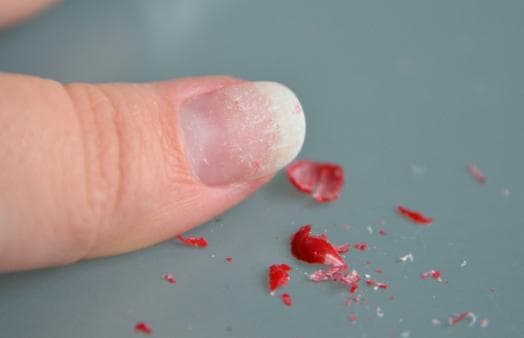
If your nails are thin, weak, deformed and prone to peeling, shellac will not stick well to them.
Sometimes after just a few days you can notice the first detachments at the cuticle, which will continue to increase. But on strong, strong nails the material holds up great.
This coating is sensitive to temperature changes. If you jump out of your apartment into the cold without gloves in winter, the shellac may soon crack.
If material detachments appear, the space between the coating and the nail becomes a suitable breeding ground for the proliferation of a wide variety of microorganisms.
In a warm and humid environment, fungus can develop, and sometimes even mold appears. Therefore, it is important to deal with them immediately when detachments appear.
Contraindications
Who should not apply shellac
- For fungal nail diseases, it is prohibited to perform any procedures other than therapeutic ones. Including shellac.
- During pregnancy, the procedure should be approached with caution. Sometimes material detachments occur due to a woman’s increased hormonal levels.
- Diabetes mellitus, again due to hormones, can also cause detachments.
Look at the photo of Pup's blush.
What you need for coverage and extensions
Let's consider what products, tools and equipment are needed to apply shellac.
Ultraviolet lamp for shellac. You simply can’t go anywhere without this item. A 9 W lamp is also suitable for home use, while in beauty salons they use a 32 W lamp. Actually, shellac itself. Three-phase is better, it consists of a transparent base with a finish and a colored component. If the base and topcoat are the same each time, then there can be as many colored bottles as you like. Buy your favorite shades and enjoy beautiful nails. In addition to the above, you will also need consumables. This:
- cotton pads;
- files;
- nail oil;
- liquid for removing shellac, gel polish;
- primer (if the technology provides for it);
- orange stick;
- manicure tools: scissors, pusher, tweezers;
- degreaser.
Video about the differences between shellac and nail extensions
Watch the video on how to apply false eyelashes to yourself.
Features of applying varnish - how to use it correctly
How to apply shellac yourself.
Before starting the procedure, remove the old nail polish, do a hygienic manicure, and shape your nails with a nail file. When performing a manicure, you must use gel to remove the cuticle. This will make the procedure easier.
After your manicure, take a nail file and remove the shine from the nail plate. Do this without fanaticism, carefully so as not to damage your nails. When the plate has become matte, it is ready to interact with shellac. Its slightly rough surface will be much better able to adhere to artificial material.
Degrease the surface of the nails with a special solution, which is called that way. This procedure will help the artificial coating to “stick” more firmly to the natural nail and ensure adhesion. If the procedure involves the use of a primer or bonder, then after degreasing, apply a drop of this drug to the plate. Not everyone knows what a shellac primer is for. It provides even better adhesion to the nail and eliminates the possibility of detachments.
Apply a clear base coat first. This is done in a thin layer. Be sure to seal the ends of the nails to prevent possible detachments of the material. After application, dry each nail for a minute in a lamp.
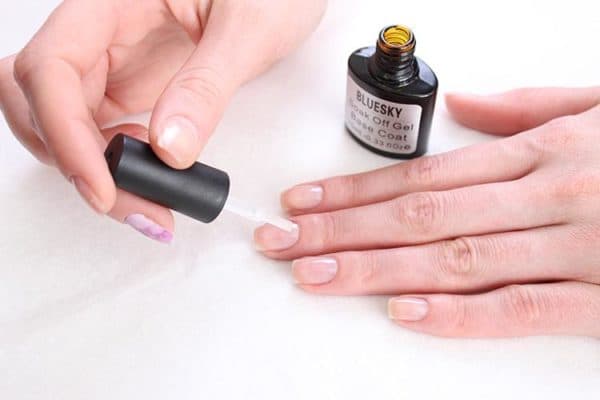
Features of applying shellac.
Be careful: sometimes when drying your nails in a lamp, especially if this is not the first procedure, you may feel quite a burning sensation on the plate. This happens if the nails are naturally very thin and soft or if a layer of shellac is applied too thick. If a burning sensation occurs, you need to remove your hand from the lamp for 2 seconds and place it there again.
The second step is to apply colored shellac. Attention: the color is usually applied in two layers, as this provides a better result and a more saturated shade. The end in this case is not sealed. Dry your nails in a lamp as you apply.
The final stage is the application of the finishing coat. It is also transparent, and when applying it you need to seal the end. The finishing coat is like a mirror, making nails ultra-shiny and hard and durable.
Video instructions for applying shellac at home
After all your nails are thoroughly dry, take some special oil and rub it into the cuticle area. This simple technique protects your nails, ensures their health, good growth and strong cuticles.
Some tips for craftsmen

Masters are several times more susceptible to side effects from using toxic products than their clients. To make work safe, and also not to encounter the development of diseases, it is recommended to follow several tips:
- Use only high-quality products - this will affect the quality of your manicure and protect you from allergies, headaches and other side effects;
- Wear gloves. Yes, it will be uncomfortable at first, but by protecting your hands, you will save your skin from contact with harmful substances of the composition;
- Use a mask to reduce the amount of fumes and dust you inhale.
Personal protective equipment for a manicurist - all types of harmful effects in the salon and how to protect yourself
How to reduce the harm of gel nail polish on healthy hands
Gel polish has improved the modern concept of manicure and is an incredibly stylish and durable product. Gel coating guarantees less harm to healthy nails.
Tips to reduce the harmful effects of gel polish:
· Do not use gel polish on nails with fungal diseases.
· Do not buy gel polish with a pungent chemical smell. The harmful substances contained in such products accumulate in the body and can cause cancer.
· Do not use gel polish after the expiration date. Closed varnish is stored for 3 years, open – 2 years.
· On weak nails that have become brittle and dull, do not use gel coating. To eliminate the causes of fragility, you should consult a specialist and undergo a course of treatment. Usually, medications with calcium and other substances that are lacking in the body are prescribed.
· If your nails were previously artificial, you should give them rest and time to recover.
· The periungual area needs to be properly nourished and moisturized so that the overall manicure looks beautiful.
· During pregnancy, it is better to abandon gel polish in favor of regular nail oils. Excessive chemical exposure to the mother’s body will definitely affect the baby’s health. The pharmacy sells medicinal products that will carefully preserve the beautiful and neat appearance of your nails.
· The UV nail drying lamp may be dangerous if purchased without inspection and warranty. The bulbs inside the lamp itself need to be replaced periodically. They are coated with a protective coating that disappears over time. The manufacturer indicates information about the lamp and its expiration date on the packaging; do not neglect this factor and do not skimp on your health.
· If you have moles or melanomas on your hands, then it is better to avoid gel polish. Drying nails in a lamp provokes skin aging and the development of melanomas. To reduce the harmful effects, use special cotton gloves with open upper phalanges. It may be recommended to apply a protective nourishing cream.
Description, benefits and harms of shellac for nails, composition, how it differs from gel polish
Girls often wonder what is better: gel polish or shellac. In this article we will look at the advantages and disadvantages of shellac.
Shellac is a decorative coating for nails, characterized by increased durability and an ultra-shiny surface.
Shellac is interesting because it successfully combines the convenience of applying regular varnish and the durability of a gel coating.
The result of this combination is a truly unique composition that allows you not to think about the condition and appearance of your nails for two weeks.
In modern conditions, when there is not enough time for anything, the durability of the coating is an important advantage.
Application Features
Shellac is applied with a brush, but dried in a UV lamp.
Professional shellac is applied not in one layer, like varnish, but in three: base, color and topcoat.
The result is a three- or four-layer “sandwich” sealed on all sides, which is firmly glued to the natural nail.
Shellac can be removed without cutting, but by soaking it in a special solvent-based liquid.
Applying shellac requires certain skills and preparation. You can’t just buy three bottles, a lamp and quickly build yourself a covering for two weeks.
Perhaps it will work, however, without knowledge of all the stages of processing and preparation of the plate, shellac will not last long.
The application procedure lasts about an hour - this is not much compared to extensions.
On video: what is shellac
We invite you to read our article with a review of Pupa lipstick.
And here you can find out how long false eyelashes last.
Look at the color palette of hair dyes Concept
Nails after shellac
Experts argue a lot about how safe such a manicure is. Some say that it all depends on the professionalism of the master and the quality of the material, others - that the main harm comes from the lamps, without which it is simply impossible to do such a manicure, others have already ruined their nails and do not recommend doing it to others, and others are completely delighted. How to figure it out?
Isn’t this the dream of every girl - a varnish that does not chip a day after application and is not afraid of housework: you can wash dishes, do laundry and mop the floors, and it will still remain in place.
Before you decide to get such a manicure, you need to find out all the pros and cons and, only after weighing everything well, make a final conclusion.
Editorial “So Simple!” I decided to understand the existing types of coatings and the possibility of selecting a durable and safe option.
Shellac Shellac and gel polish. Is there a difference between them? Yes, it exists, but it’s not that significant.
Shellac is the same as gel polish, only more expensive. Before applying gel polish, the nail is polished (this, by the way, thins the nail plate). Removing this coating also injures the nail.
But before applying shellac, the nail is degreased, which allows you to maintain the health of the nail longer. You can purchase the original only from official dealers, and the color palette is more meager than that of gel polish.
Gel polish Gel polish is ideal for those who love beautiful, well-groomed and bright nails, but do not want to repaint them several times a week. The advantage of gel polish is that its shine cannot be compared with the shine of regular polish, which will never be as deep.
In addition, the shine of the gel polish lasts for two weeks. At the same time, your nails look as if you just left a beauty salon! But the consequences of its application leave much to be desired.
Regular varnishes and medicinal compositions Regular varnishes are not as convenient, but still a good alternative. Fix the varnish with a product that adds gloss, and externally it will not be so easy to distinguish the varnish from the gel.
There are also remedies. They can be bought at the pharmacy. Not only will they not cause harm, but they will also help strengthen your nails and restore their shine and strength.
Vinylux Vinylux is a professional coating that promises to stay on your nails for a week. You can apply it at home, and purchase it at any specialized nail store.
The procedure consists of only three steps: you need to apply two layers of the selected varnish, and cover your nails with a top coat (usually included in the kit). Lamp drying is not needed.
Long-lasting varnishes With the advent of a large number of long-lasting coatings, many manufacturers changed the formula, and long-lasting nail varnishes were born. Now they stay on the nails for at least 7-10 days. True, to achieve this result you need to have a top and base coat on hand.
Shimmers can be an excellent solution. These are varnishes with large sparkles. They literally stick tightly to your nails. True, they are not easy to remove, but the desired durability is indeed present.
Stickers Today, such know-how as nail stickers has appeared on the fashion industry market.
This manicure is done quite quickly: the selected sticker is glued to the nail; for quick drying, you can place the nails under a special lamp, then remove the excess with a nail file. This nail art can be done at home, and most importantly, it does not injure the nail.
Manufacturers of such stickers guarantee 2 weeks of durability. However, for a friend of mine, such stickers lasted a little less than a week!
I would be very glad if this article was useful to you and you discovered something new. Let your nails be healthy, strong and beautiful, and let discomfort, infections, fragility and discomfort pass you by. Have a beautiful manicure!
Tell your friends about these useful things and life hacks. And check out other fun summer manicure ideas!
published on according to the materials
The entry was taken from the website.
How to treat?
It is difficult to make a timely diagnosis, since the tumor resembles a subungual hematoma. Dermatoscopy and epiluminescent microscopy help to figure it out - visual assessment of altered tissues using magnification and examination of them in an immersion environment. The final diagnosis is made after a histological conclusion, but it is not recommended to take a biopsy - metastases may occur.
The main method in the treatment of melanoma is amputation at the level of the middle phalanx of the finger. Radiation therapy is used to irradiate recurrent tumors in the area of the postoperative scar and lymph nodes to prevent metastases. Chemotherapy can reduce the size of the tumor and destroy the remains of malignant cells.
But, unfortunately, today the effect of these methods can be achieved only in 15-20% of patients - all because subungual melanoma is characterized by an aggressive course. Most often, metastases are later found in the lungs and liver.
8255
There are no “former” cancer patients
The prognosis depends on the thickness of the tumor, the level of invasion and the presence of distant metastases. The five-year life expectancy without metastases is about 60%, half of the patients die after 4.5 years. If there are metastases, death can occur within 7-8 months.
Does gel coating harm pregnant women and nursing mothers?
During the process of bearing a baby, a woman's body experiences many changes, both external and internal, including hormonal. A lot of girls are often interested in whether it is harmful to do gel polish while pregnant? We confidently assert that modern gel polishes and shellac of proper quality are not dangerous. They can do no harm either during pregnancy or during lactation.
Moreover, gel polish benefits your nails. During pregnancy, not only a woman’s hair, but also her nails become brittle. And such a manicure will be able to protect the nail plates from harmful effects, and will also help to artificially strengthen them until the body returns to normal.
Gel polish – benefit or harm?
The history of manicure is long and very interesting.
As you know, even in the times of Ancient Egypt and Ancient Rome, people paid close attention to caring for their hands, since it was believed that they could determine the status of a person. This trend continued into the Victorian era of primness and aristocracy.
At that time, only representatives of blue blood could boast of neat nails and absolutely snow-white fingers. The first and most important forefather of manicure is rightfully considered the French king Louis Philippe, who in 1930 performed the procedure of hygienic trimmed manicure. Since then, the nail service industry has been developing by leaps and bounds and modern beauties barely have time to try all the trends.
The first nail polish appeared in 1900, and by 1932 Charles Lashman was able to develop a formula for a long-lasting color coating that won the hearts of millions of the fair sex around the world. Of course, at that time women did not question the safety of varnishes for the body. And, in fairness, we note that the composition of these miniature glass bottles was very, very deplorable. By the beginning of 1980, acrylic appeared on sale, which was used to build long, sharp, predatory claws. And later acrylic was successfully replaced by gel, which hardens under the light of an ultraviolet lamp. It was this phenomenal discovery that made a revolution in the nail industry, because it was the appearance of extension gel that provoked the birth of its derivatives - gel varnishes of all colors of the rainbow.
The American company Creative Nail Design (CND), led by its founder Stuart Nordstrom, took the lead in this difficult task. This maestro created the notorious shellac, which turned the world of lovely ladies upside down. There was no longer any need to repaint your nails every 2 days, or suffer from chipping and dulling of the coating - the unrivaled color and perfect durability made shellac an absolute hit of the 20th century. Naturally, other competing manicure companies did not want to put up with this state of affairs and they began developing their own varnish formulas. So the Kodi and OPI jars saw the light of day, and after that many others
It is important to remember that shellac and gel polish are not synonymous, although in colloquial speech these two concepts are often confused. Undoubtedly, gel manicure is the most convenient way to maintain the presentability of your fragile fingers for a long time, but is it really safe? Find details below
Myth 2: Nails turn yellow.
Many people believe that nails under gel polish turn yellow and become brittle. This is possible if the master uses cheap products during the work process and also dries out the nails under the lamp.
- The first step is to prepare the nail plate for gel polish: adjust the shape, length and sand down any irregularities.
- The next step is to apply a primer, which degreases the nail for better adhesion to the polish.
- Then apply the base necessary to prevent the penetration of varnish pigments into the nail plate.
- Then you can apply the gel polish itself in two layers.
- The last stage is a glossy or matte top coat.
An unqualified master may forget to apply the base and begin to cover the nails immediately after degreasing, or may not process the nails enough or not completely remove the old coating. You need to follow the actions of the master and speak immediately if you feel pain.
Is gel polish harmful to health?
Gel polish may be harmful to health in some cases:
- When coating is done for obvious problems with nails. For example, they are thinned, pain is felt, there is a gray coating on the surface, or the color in some places has turned green or brown. This may indicate the development of a fungal disease or burn, which requires treatment, not design.
- When the coating is poorly dried, that is, it is polymerized on top, but closer to the nail it remains wet. This is another favorable factor for an infection called Pseudomonas - Pseudomonas. It makes the natural nail green.
- When there is an allergy. It may not appear immediately, but as the unwanted substance accumulates in the body. That is, not even from the first manicure, but after correction with the same means. The fingers begin to itch and hurt, the skin turns red and becomes wet.
- When there are detachments of the material, and the girl does not remove it for weeks. The narrow space between the nail and the coating is a favorable environment for bacteria. Dirt and sweat get in there and are difficult to clean out. The result is a change in the color and structure of the plate, indicating a degenerative process or infection.
- When the cuticle is not cleaned thoroughly enough, and varnish has flowed into it. This is also the cause of the inflammatory process, and then suppuration. At first a small wound forms, then it grows, and the pain intensifies. As a result, the nail may begin to grow already changed - lumpy and peeling.
- When the coating is cut off indoors without an exhaust hood and without a mask on the face. Small particles enter the respiratory tract and can cause asthma. Those who often have colds and are prone to allergies are especially at risk.
Is shellac harmful for nails: allergy to gel polish
Most often, allergies appear with repeated use of shellac, so you should not get carried away with it. The cause of an allergic reaction may be intolerance to individual components of the varnish, of which the most harmful is methacrylate.
Allergies can manifest themselves in different ways. Most often this is severe itching in the area of the fingers. A rash appears on the skin, blisters form, in place of which dark pigment spots soon appear, which cannot be gotten rid of with ordinary ointments. A rash appears on the palms, which resembles herpes. The nail plate may peel.
There are allergy symptoms such as:
- swelling in the affected area;
- hyperemia (increased blood flow) on the hands;
- rash in the shoulder and neck area;
- dryness and roughness of the skin.
A dangerous reaction is considered to be angioedema of the nasopharyngeal mucosa, which leads to difficulty breathing.
Manufacturers of harmless coatings
In this case, a suitable definition is gel polishes with the most natural composition. Experts identify several manufacturers who, in addition to durability and beauty, also take care of the health of marigolds.
Gels from In Garden So naturally contain silicones, resins and natural nutrients, which allows you to further restore and strengthen the nail plate. Therefore, the brand is relevant to use even for brittle and peeling nails. The product is resistant to damage and has an affordable price.
Irisk Professional varnish is highly durable and dries quickly
The brand belongs to the type of hypoallergenic products, which is important. The product helps strengthen the nail and reduces natural fragility, and also prevents yellowing of the nail plate and is resistant to humid environments.
Entity One has a special structure, due to which the varnish itself seems to level out
This characteristic allows you to visually smooth out unevenness and cracks in the nail. The brand has proven itself to have excellent durability, convenient bottles and increased strength of natural nails.
The Jessica Geleration brand has also become famous due to its harmlessness. The varnish is considered quite convenient to use. The only downside is the uncomfortable brush.
The Axxium OPI brand became one of the most popular last year. There is no need to file the nail plate before applying the polish. It has the ability to effectively strengthen nails.
The Kodi brand made a splash on the gel polish market due to its unusual rubber base. A natural component that provides excellent adhesion to the nail and does not harm it at all. In addition, the brand took care of strengthening the nail plate.
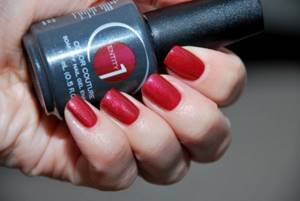
7 photos
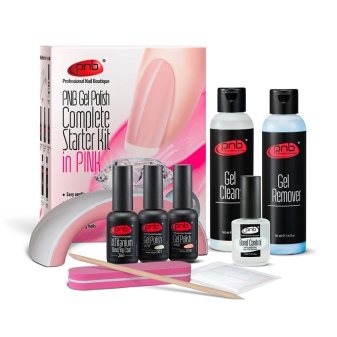
The benefits of shellac for nails
This manicure has many advantages that will delight lovers of well-groomed hands.
Main advantages:
the ability to quickly grow nails. Shellac promotes the appearance of a dense shell on the nail, prevents creases, and helps solve the problem of delamination of the nail plate. Therefore, exposure to chemicals and high temperatures becomes less harmful;
There are no formaldehydes in the composition, so the varnish is harmless. This manicure is not contraindicated for pregnant and lactating women;
The coating will stay on the nails for a long time, which is very convenient. To remove gel polish you need special products, so household chemicals are not scary for it;
If your nails are flaky and thin, shellac is the ideal solution. A durable coating protects the fragile nail plate from the negative effects of external factors. While the gel polish covers the plate, the nails can grow back strong and healthy;
shellac gives nails beauty and a glossy shine that will not fade over time;
A varied palette of colors makes it possible to create a manicure for every taste. The range of colors is constantly updated with fashionable shades in accordance with the trends of the season.
The benefits of shellac are undeniable. The main thing is to properly care for your nails and have your manicure done by a good specialist. You can't skimp on quality. You can ask the master what products he uses, since cheap varnishes contain harmful substances that destroy the nail plate and lead to brittleness.
Scientists: shellac is dangerous to health
Shellac fans should be careful: using ultraviolet rays during the drying process carries a risk of serious illness. We tell you what the features of this nail coating are and how to prevent unpleasant consequences without giving up the benefits of shellac.
What is shellac
Shellac is an excellent alternative to varnish, created for those who want to maintain perfect nail coverage for a long time. This coating is a hybrid of two nail products at once, namely regular varnish and modeling gel.
From the first he inherited the application technique, appearance and rich color palette. From the second - incredible durability. Shellac coating can stay on nails for up to three weeks without chipping or other changes.
The only thing that will give away the “age” of the manicure is the overgrown areas of the nail at the base.
The technique of applying shellac is a little more intricate than that of a conventional coating, so the procedure is carried out in salons; it will be difficult to carry it out at home without special equipment.
An important step is the grinding process, which allows you to level the nail plate and remove excess “burrs” and “bumps”. A smooth surface is the key to strong adhesion of the varnish to the nail.
The next stage is degreasing, after which a special base coat is applied to the nail. It protects the nail from the harmful effects of pigments in the color layer and improves the adhesion of the varnish to the nail plate.
Next, the colored coating is applied in two layers.
The main difference between shellac and regular varnish is that after each layer, the nail is dried for a minute under an ultraviolet (in some cases LED) lamp. The coating is polymerized and fixed only after exposure to rays.
As for removing shellac, it is also better to entrust this procedure to professionals rather than doing it yourself. Acetone coating is not so easy to remove.
Although if you really need it, you can - then to do this you need to soak a cotton pad in the solution, wrap it around your nail and secure it with foil; After about 10 minutes you can scrape off the shellac. But be careful, with this method there is a high probability that you will dry out the nail.
In the salon, shellac is removed with a special compound, which acts much more gently, although subsequent polishing of the nail from the remaining coating will also be a rather traumatic procedure.
Note that shellac is considered a hypoallergenic coating, since it is odorless and does not contain toluene, dibutylphthalan, formaldehyde and its resins.
Why is shellac dangerous?
There is an opinion that shellac is an extremely harmful procedure for the nail. It is believed that such a coating is too aggressive on the nail plate. In addition, the processes of grinding and polishing the nail can seriously injure the nail.
All these manipulations are indeed capable of thinning the nail, but only the segment to which they are directed. That is, they cannot completely change the structure of the nail forever.
A month or two without shellac and your nails will regain their usual appearance.
Another point that causes controversy is the drying process of shellac, which occurs under special lamps. Some scientists are inclined to argue that the ultraviolet lamp, which is used to dry each layer of coating, can be hazardous to health.
Moreover, one of the most common forms of the disease affects the skin of the hands and the area around the nails.
How to protect yourself
- The first and main advice is to give your nails a rest. If you regularly do shellac, then the best solution would be to take a break every one and a half to two months and switch to a regular or medicated coating for a couple of weeks. Moreover, shellac lasts much worse on thin and broken nails than on healthy ones.
- To protect yourself as much as possible from the harmful effects of lamps, doctors recommend using hand sunscreen with an SPF factor of at least 15 before the procedure. Another option is to choose salons that use not ultraviolet, but LED lamps, which are considered safer, to fix the coating.
Source
Gel and its harmful features
The gel belongs to the polymer hard coating. Using it, nails:
- They model.
- Lengthen.
- Change shape.
An ultraviolet or LED lamp is used for application, which allows:
- Harden the coating.
- Apply any design.
- Do not adjust the nail plate for 3 weeks.
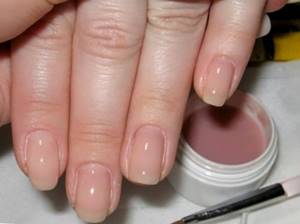
Gel happens:
- A hard , durable polymer that turns a natural nail into an artificial one.
- Soft , elasticity is given to it by protein or rubber, the composition is used to level the nail plates; they cannot be lengthened in this way.
As always, the cause of harmful manifestations from gels is the manufacturer or manicurist:
- Detection of onycholysis or detachment of the cornea from the fingers.
- Change in color of the nail plate.
- Fungal infections, rashes due to poorly processed saw blades.
After constant gel coating, when the nails are not given rest, the negative consequences are manifested by the formation of:
- Yellowing.
- Irregularities and bumps.
- Bundles.
- Dullness.
- Thinning.
- Brittleness with the appearance of cracks.
If the skin or nail is affected, substances that have a negative effect on internal organs can enter the body through it:
- Kidneys.
- Liver.
- Lungs.
To avoid consequences, you need to carefully consider the composition of the gel and the production company.

